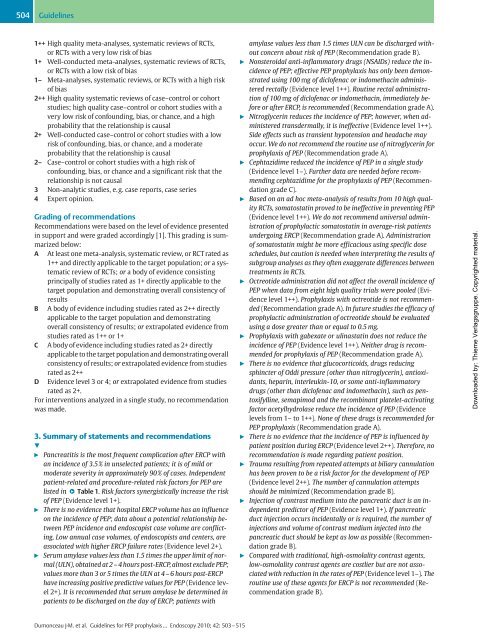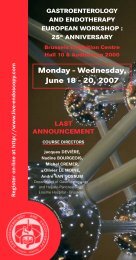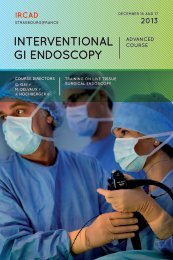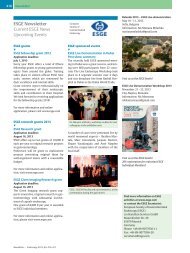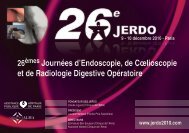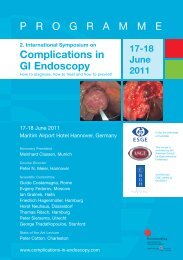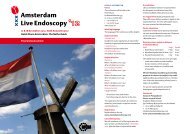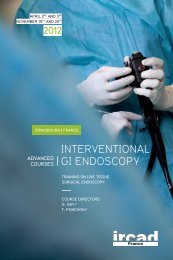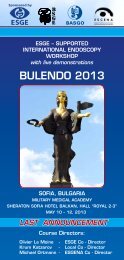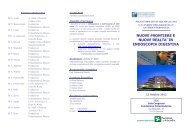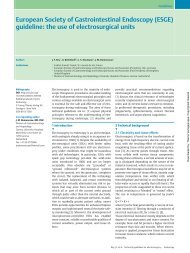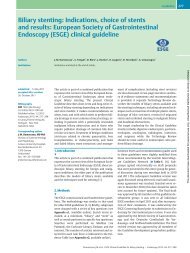(ESGE) Guideline: Prophylaxis of post-ERCP ... - ResearchGate
(ESGE) Guideline: Prophylaxis of post-ERCP ... - ResearchGate
(ESGE) Guideline: Prophylaxis of post-ERCP ... - ResearchGate
You also want an ePaper? Increase the reach of your titles
YUMPU automatically turns print PDFs into web optimized ePapers that Google loves.
504<br />
<strong>Guideline</strong>s<br />
1++ High quality meta-analyses, systematic reviews <strong>of</strong> RCTs,<br />
or RCTs with a very low risk <strong>of</strong> bias<br />
1+ Well-conducted meta-analyses, systematic reviews <strong>of</strong> RCTs,<br />
or RCTs with a low risk <strong>of</strong> bias<br />
1– Meta-analyses, systematic reviews, or RCTs with a high risk<br />
<strong>of</strong> bias<br />
2++ High quality systematic reviews <strong>of</strong> case–control or cohort<br />
studies; high quality case–control or cohort studies with a<br />
very low risk <strong>of</strong> confounding, bias, or chance, and a high<br />
probability that the relationship is causal<br />
2+ Well-conducted case–control or cohort studies with a low<br />
risk <strong>of</strong> confounding, bias, or chance, and a moderate<br />
probability that the relationship is causal<br />
2– Case–control or cohort studies with a high risk <strong>of</strong><br />
confounding, bias, or chance and a significant risk that the<br />
relationship is not causal<br />
3 Non-analytic studies, e.g. case reports, case series<br />
4 Expert opinion.<br />
Grading <strong>of</strong> recommendations<br />
Recommendations were based on the level <strong>of</strong> evidence presented<br />
in support and were graded accordingly [1]. This grading is summarized<br />
below:<br />
A At least one meta-analysis, systematic review, or RCT rated as<br />
1++ and directly applicable to the target population; or a systematic<br />
review <strong>of</strong> RCTs; or a body <strong>of</strong> evidence consisting<br />
principally <strong>of</strong> studies rated as 1+ directly applicable to the<br />
target population and demonstrating overall consistency <strong>of</strong><br />
results<br />
B A body <strong>of</strong> evidence including studies rated as 2++ directly<br />
applicable to the target population and demonstrating<br />
overall consistency <strong>of</strong> results; or extrapolated evidence from<br />
studies rated as 1++ or 1+<br />
C A body <strong>of</strong> evidence including studies rated as 2+ directly<br />
applicable to the target population and demonstrating overall<br />
consistency <strong>of</strong> results; or extrapolated evidence from studies<br />
rated as 2++<br />
D Evidence level 3 or 4; or extrapolated evidence from studies<br />
rated as 2+.<br />
For interventions analyzed in a single study, no recommendation<br />
was made.<br />
3. Summary <strong>of</strong> statements and recommendations<br />
!<br />
" Pancreatitis is the most frequent complication after <strong>ERCP</strong> with<br />
an incidence <strong>of</strong> 3.5 % in unselected patients; it is <strong>of</strong> mild or<br />
moderate severity in approximately 90% <strong>of</strong> cases. Independent<br />
patient-related and procedure-related risk factors for PEP are<br />
listed in ● " Table 1. Risk factors synergistically increase the risk<br />
<strong>of</strong> PEP (Evidence level 1+).<br />
" There is no evidence that hospital <strong>ERCP</strong> volume has an influence<br />
on the incidence <strong>of</strong> PEP; data about a potential relationship between<br />
PEP incidence and endoscopist case volume are conflicting.<br />
Low annual case volumes, <strong>of</strong> endoscopists and centers, are<br />
associated with higher <strong>ERCP</strong> failure rates (Evidence level 2+).<br />
" Serum amylase values less than 1.5 times the upper limit <strong>of</strong> normal<br />
(ULN), obtained at 2–4 hours <strong>post</strong>-<strong>ERCP</strong>, almost exclude PEP;<br />
values more than 3 or 5 times the ULN at 4 – 6 hours <strong>post</strong>-<strong>ERCP</strong><br />
have increasing positive predictive values for PEP (Evidence level<br />
2+). It is recommended that serum amylase be determined in<br />
patients to be discharged on the day <strong>of</strong> <strong>ERCP</strong>; patients with<br />
Dumonceau J-M. et al. <strong>Guideline</strong>s for PEP prophylaxis … Endoscopy 2010; 42: 503 –515<br />
amylase values less than 1.5 times ULN can be discharged without<br />
concern about risk <strong>of</strong> PEP (Recommendation grade B).<br />
" Nonsteroidal anti-inflammatory drugs (NSAIDs) reduce the incidence<br />
<strong>of</strong> PEP; effective PEP prophylaxis has only been demonstrated<br />
using 100 mg <strong>of</strong> dicl<strong>of</strong>enac or indomethacin administered<br />
rectally (Evidence level 1++). Routine rectal administration<br />
<strong>of</strong> 100 mg <strong>of</strong> dicl<strong>of</strong>enac or indomethacin, immediately before<br />
or after <strong>ERCP</strong>, is recommended (Recommendation grade A).<br />
" Nitroglycerin reduces the incidence <strong>of</strong> PEP; however, when administered<br />
transdermally, it is ineffective (Evidence level 1++).<br />
Side effects such as transient hypotension and headache may<br />
occur. We do not recommend the routine use <strong>of</strong> nitroglycerin for<br />
prophylaxis <strong>of</strong> PEP (Recommendation grade A).<br />
" Cephtazidime reduced the incidence <strong>of</strong> PEP in a single study<br />
(Evidence level 1–). Further data are needed before recommending<br />
cephtazidime for the prophylaxis <strong>of</strong> PEP (Recommendation<br />
grade C).<br />
" Based on an ad hoc meta-analysis <strong>of</strong> results from 10 high quality<br />
RCTs, somatostatin proved to be ineffective in preventing PEP<br />
(Evidence level 1++). We do not recommend universal administration<br />
<strong>of</strong> prophylactic somatostatin in average-risk patients<br />
undergoing <strong>ERCP</strong> (Recommendation grade A). Administration<br />
<strong>of</strong> somatostatin might be more efficacious using specific dose<br />
schedules, but caution is needed when interpreting the results <strong>of</strong><br />
subgroup analyses as they <strong>of</strong>ten exaggerate differences between<br />
treatments in RCTs.<br />
" Octreotide administration did not affect the overall incidence <strong>of</strong><br />
PEP when data from eight high quality trials were pooled (Evidence<br />
level 1++). <strong>Prophylaxis</strong> with octreotide is not recommended<br />
(Recommendation grade A). In future studies the efficacy <strong>of</strong><br />
prophylactic administration <strong>of</strong> octreotide should be evaluated<br />
using a dose greater than or equal to 0.5 mg.<br />
" <strong>Prophylaxis</strong> with gabexate or ulinastatin does not reduce the<br />
incidence <strong>of</strong> PEP (Evidence level 1++). Neither drug is recommended<br />
for prophylaxis <strong>of</strong> PEP (Recommendation grade A).<br />
" There is no evidence that glucocorticoids, drugs reducing<br />
sphincter <strong>of</strong> Oddi pressure (other than nitroglycerin), antioxidants,<br />
heparin, interleukin-10, or some anti-inflammatory<br />
drugs (other than dicl<strong>of</strong>enac and indomethacin), such as pentoxifylline,<br />
semapimod and the recombinant platelet-activating<br />
factor acetylhydrolase reduce the incidence <strong>of</strong> PEP (Evidence<br />
levels from 1– to 1++). None <strong>of</strong> these drugs is recommended for<br />
PEP prophylaxis (Recommendation grade A).<br />
" There is no evidence that the incidence <strong>of</strong> PEP is influenced by<br />
patient position during <strong>ERCP</strong> (Evidence level 2++). Therefore, no<br />
recommendation is made regarding patient position.<br />
" Trauma resulting from repeated attempts at biliary cannulation<br />
has been proven to be a risk factor for the development <strong>of</strong> PEP<br />
(Evidence level 2++). The number <strong>of</strong> cannulation attempts<br />
should be minimized (Recommendation grade B).<br />
" Injection <strong>of</strong> contrast medium into the pancreatic duct is an independent<br />
predictor <strong>of</strong> PEP (Evidence level 1+). If pancreatic<br />
duct injection occurs incidentally or is required, the number <strong>of</strong><br />
injections and volume <strong>of</strong> contrast medium injected into the<br />
pancreatic duct should be kept as low as possible (Recommendation<br />
grade B).<br />
" Compared with traditional, high-osmolality contrast agents,<br />
low-osmolality contrast agents are costlier but are not associated<br />
with reduction in the rates <strong>of</strong> PEP (Evidence level 1–). The<br />
routine use <strong>of</strong> these agents for <strong>ERCP</strong> is not recommended (Recommendation<br />
grade B).<br />
Downloaded by: Thieme Verlagsgruppe. Copyrighted material.


